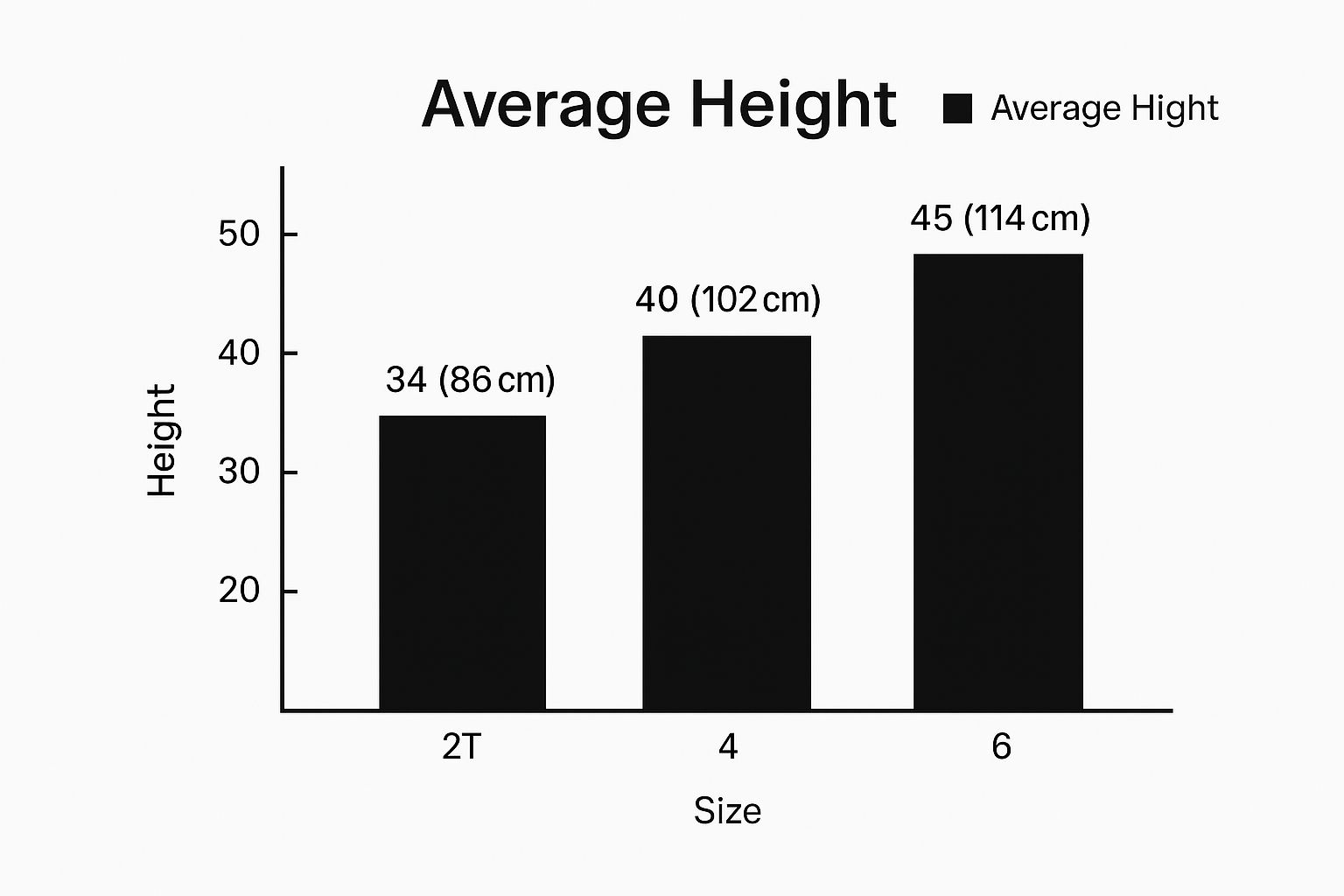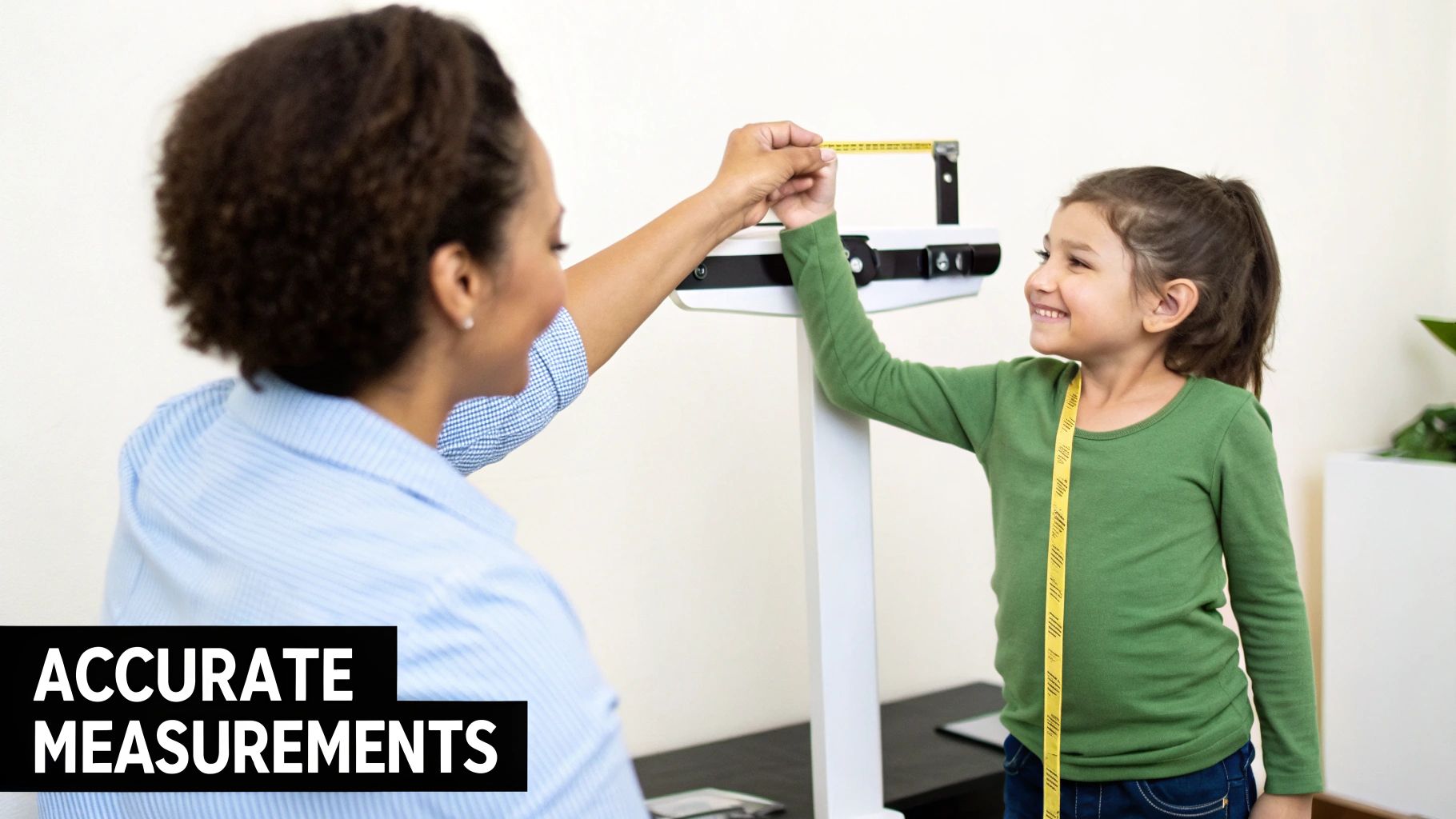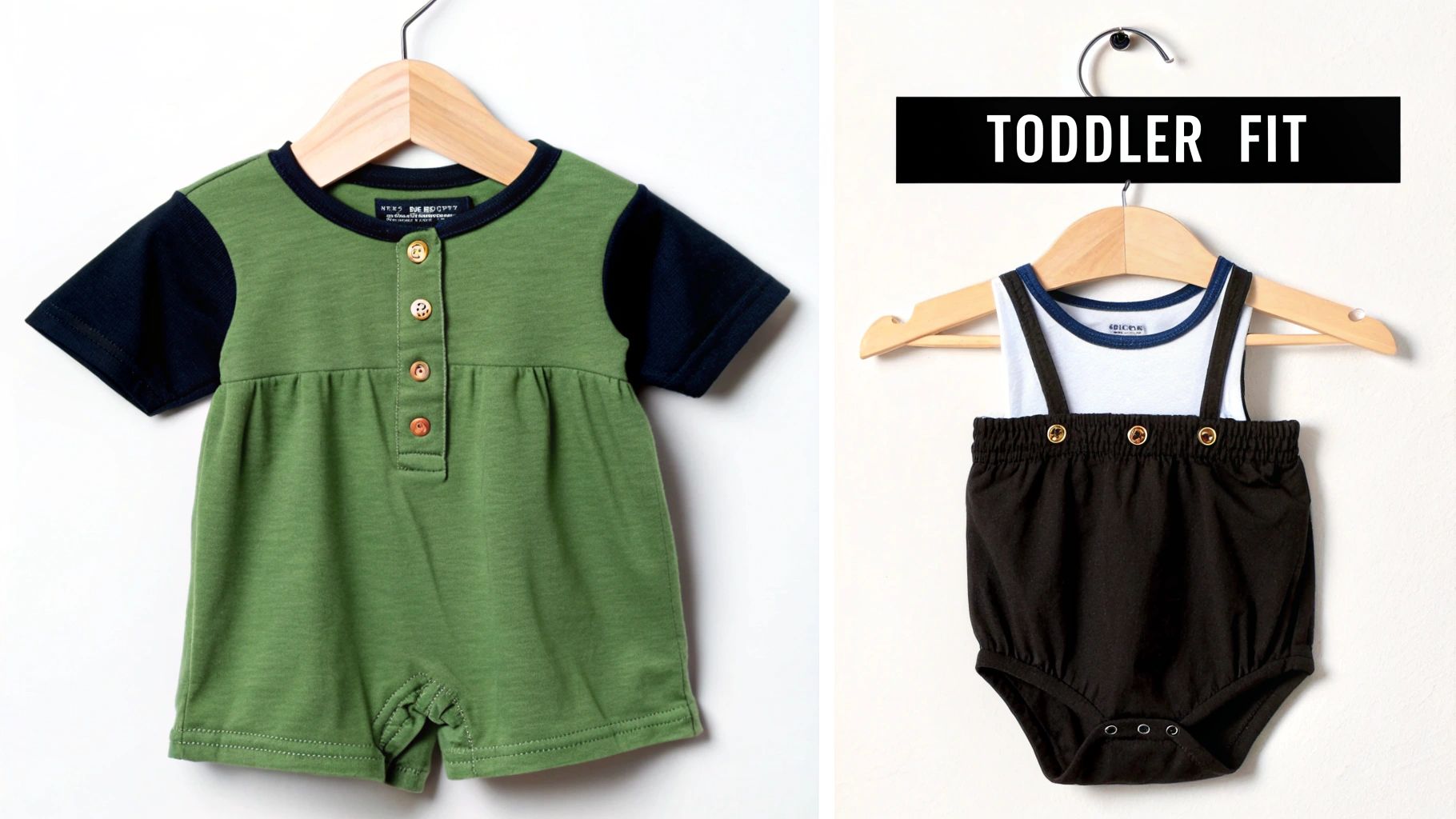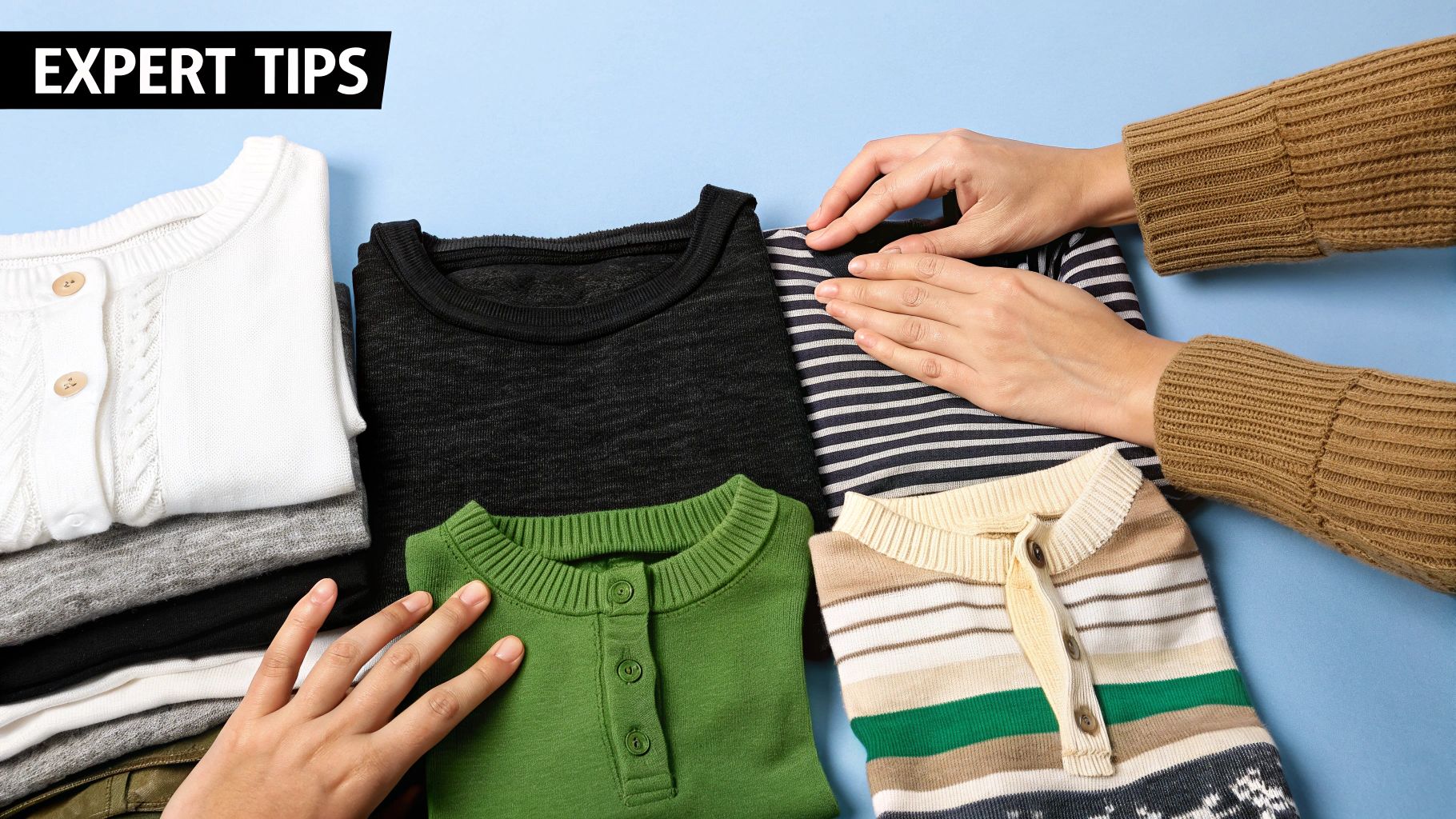Shopping for kids can feel like a constant guessing game, especially since they grow so fast. A good kids clothing size chart is a parent's best friend, taking the mystery out of picking sizes from 2T to 7 by using a child's age, height, and weight. This guide is here to make that process a whole lot easier for parents of toddlers and young children.
Your Quick Reference Kids Clothing Size Chart for Toddlers and Kids (2T-7)
Let's be honest, finding the right clothing size for a growing child often feels like trying to hit a moving target. Sizes can be wildly different from one brand to the next, and growth spurts seem to happen overnight. A standard chart gives you a reliable starting point, turning your child's measurements into a size you can actually use.
Having a go-to reference is a lifesaver, whether you're clicking "add to cart" online or browsing the racks in a store. It helps you avoid the frustrating cycle of buying clothes that are already too tight or comically oversized. Ultimately, it saves you time, cuts down on returns, and makes sure your kid is comfortable.
This chart gives you a quick visual for the average height you can expect for toddlers and young kids in the 2T to 7 range.

As you can see, there's a pretty consistent jump of about 5-6 inches in height between sizes 2T, 4, and 6, which lines up with those major growth milestones.
At-a-Glance Sizing 2T to 7
To make things even simpler, here's a detailed table breaking down the typical age, height, and weight for sizes 2T through 7. Think of it as your cheat sheet before you head out to shop or start browsing online.
Kids Clothing Size Chart 2T to 7
| US Size | Age Range | Height (in) | Weight (lbs) | Height (cm) | Weight (kg) |
|---|---|---|---|---|---|
| 2T | 2 years | 33-36" | 29-32 lbs | 84-91 cm | 13-14.5 kg |
| 3T | 3 years | 36-39" | 32-35 lbs | 91-99 cm | 14.5-16 kg |
| 4T | 4 years | 39-42" | 35-39 lbs | 99-107 cm | 16-17.5 kg |
| 5 | 5 years | 42-45" | 39-44 lbs | 107-114 cm | 17.5-20 kg |
| 6 | 6 years | 45-48" | 44-50 lbs | 114-122 cm | 20-22.5 kg |
| 7 | 7 years | 48-50" | 50-56 lbs | 122-127 cm | 22.5-25 kg |
Keep this chart handy! It's the perfect quick-lookup tool to ensure you're grabbing the size most likely to fit your child well.
How to Accurately Measure Your Child
Getting the right fit all starts with good measurements. A size chart is only as good as the numbers you’re comparing it to, so taking a few minutes to measure accurately can save you a ton of hassle later.
With the children's apparel market expected to hit an incredible USD 366.72 billion by 2032, the number of brands and styles to choose from is massive. Your child's unique measurements are the single best tool you have for cutting through the confusion and finding what actually fits.

Before you begin, find a soft, flexible measuring tape. No tape? No problem. A piece of string and a ruler work just fine. For the best results, have your child wear only their underwear or thin, snug-fitting clothes.
Key Measurements for Clothing Fit
Taking measurements can be tricky with a squirmy kid, so try to make it fun. Turning it into a game like "Let's see how tall a superhero you are!" can make all the difference.
Here’s how to get the four most important numbers for sizes 2T to 7T:
- Height or Length: For kids who can stand, have them stand tall against a wall with their heels touching it. Gently place a book flat on their head and mark where the bottom of the book touches the wall. For babies, it's easiest to measure them while they're lying down flat.
- Chest: Wrap the measuring tape around the fullest part of their chest, keeping it level right under their armpits. The tape should be snug, but not digging in.
- Waist: Find their natural waistline by measuring around the narrowest part of their torso. This is usually right around their belly button.
- Inseam: This one is key for pants. Measure the inside of their leg, starting from the crotch and going straight down to their ankle bone.
Pro Tip: It never hurts to measure twice! Write down the numbers in both inches and centimeters, because you'll find that brands use different systems on their size charts.
Once you have these measurements, you can say goodbye to the guessing game. To learn more about how height, in particular, plays a role in sizing, take a look at our complete children's clothes height guide. Having accurate numbers means you can shop confidently, cut down on returns, and make sure your child is comfortable in clothes that fit just right.
Decoding Toddler Sizes: What 2T Through 5T Really Means
Walking into the toddler section can feel like a whole new world, especially when you see sizes like 2T, 3T, and 4T. What does that "T" actually mean? It’s not just an arbitrary letter; it’s a crucial detail that points to a specific cut designed for a toddler's unique body shape.

The "T" simply stands for toddler. Garments with this label are proportioned for little ones who are still a bit wobbly on their feet and, most importantly, are likely still wearing a diaper.
This means "T" clothes are designed with extra room in the seat to accommodate that diaper bulk. You’ll also notice they often have a slightly shorter inseam and a rounder fit overall. This isn't an accident—it's smart design that prevents bunching and gives your child total freedom to move, explore, and play without their clothes getting in the way.
The Big Difference: 4T vs. Size 4
Here’s where a lot of parents get tripped up. Is a 4T the same as a regular kids' size 4? Nope. They're designed for a similar age, but they are absolutely not interchangeable. The main differences come down to the overall silhouette and length.
Let's break it down:
- Fit and Shape: A 4T is built for a toddler's body, meaning it’s wider and rounder through the torso and bottom to make space for a diaper. A size 4, in contrast, is cut slimmer and straighter for a potty-trained child who has a less rounded tummy and bottom.
- Length: Regular size 4 clothing is almost always longer, both in the torso and the inseam. This accounts for that growth spurt that often happens right as kids move out of the toddler stage.
- Sleeves: You might also find that size 4 shirts have slightly longer and slimmer sleeves than their 4T counterparts.
The simplest way to think about it is that "T" sizes are for a toddler's current proportions—short, round, and diaper-clad. Regular kids' sizes are for the leaner, taller frame of a young child who's moved on from diapers.
So, when do you make the switch? It has less to do with their age and more to do with their body shape. Once your child is potty-trained and starts looking a little taller and less rounded, it’s probably time to move up from 4T to a size 5 or a regular size 4.
Getting to Know Big Kids Sizes: 4 Through 7
Once your little one graduates from the toddler section, you'll notice a significant shift in how their clothes are sized. This is where the straightforward sizes 4, 5, 6, and 7 come into play, marking a fun milestone as they move away from diaper-friendly clothing and into styles designed for a school-aged kid.
The biggest difference? The cut. These "big kid" sizes have a noticeably different silhouette compared to their "T" (toddler) counterparts. They're designed with a slimmer profile and are longer in the body and legs. This change makes sense, as it’s for a child who is potty-trained and has a less rounded, more developed frame. A great example is seeing a size 4 pant next to a 4T—the size 4 will be longer and less roomy in the seat.
Finding the Right Fit from Size 4 to 7
While every brand has its own quirks, knowing the general measurements for these sizes gives you a great starting point for shopping. It helps you make smarter choices and avoid the dreaded dressing room meltdown.
Here’s a quick reference for what to look for:
- Size 4: This is the first step out of toddler proportions. It generally fits kids who are 39-42 inches tall and weigh 35-39 pounds.
- Size 5: Perfect for children measuring around 42-45 inches in height and weighing between 39-44 pounds.
- Size 6: Look for this size when your child is about 45-48 inches tall and weighs in at 44-50 pounds.
- Size 7: This size usually fits kids who have reached 48-50 inches in height and weigh roughly 50-56 pounds.
Keep in mind that these sizes are built for active kids. The longer, leaner cut is meant to give them the freedom to run, jump, and climb without their clothes getting in the way.
What Is a Size 6X?
Every so often, you'll spot a size 6X on the rack. Think of it as a helpful in-between size. It’s designed to bridge the gap between a size 6 and a size 7, offering a little extra room without the full jump in length.
A 6X is perfect for a child who might need a bit more width through the chest or waist but isn't quite tall enough for a standard size 7 just yet.
Expert Tips for Choosing the Right Fit
The numbers on a kids' clothing size chart are a great starting point, but they don't tell the whole story. To find clothes that truly fit well, feel comfortable, and last through a few growth spurts, you need to look beyond the tag. This is where a little bit of fabric knowledge and understanding your child's unique shape can turn you into a pro.

It’s an especially useful skill to have these days. With the kids' apparel market expected to hit an incredible USD 420,310.5 million by 2035, our options are exploding. That also means more sizing inconsistencies between brands. A smart shopper knows how to look at an item and predict how it will actually wear on their child.
Consider the Material and Build
The type of fabric used in a garment makes a massive difference in how it fits. A soft, stretchy cotton blend has a lot more give than a crisp, woven material like denim, which can be pretty unforgiving.
Here’s a quick breakdown:
- Knit Fabrics: Think of your classic t-shirts, leggings, and sweats. These fabrics stretch and move with your child, offering a much more flexible fit if they happen to be between sizes.
- Woven Fabrics: This category includes things like structured button-down shirts, chinos, or formal dresses. They don't have much stretch, so getting the measurements right is crucial for a good fit.
- Your Child’s Build: Every kid is different. Is your child lean and long-limbed, or do they have a more solid, sturdy frame? Some brands are known for cutting their clothes on the slimmer side, while others are great for offering a bit more room.
Read Reviews and Plan for Growth
One of your best tools is the collective wisdom of other parents. Customer reviews are a goldmine of information, often telling you if a specific shirt runs big, if those pants shrink in the wash, or if an item is true to size. This kind of real-world feedback is invaluable.
Buying a size up is a time-tested trick to get more mileage out of an outfit, but it requires a bit of strategy. Don't just buy a huge shirt they'll be swimming in! Instead, look for smart features like adjustable waistbands, rollable cuffs on sleeves and pants, or elasticated hems that help the clothes fit well now with room to grow.
By combining good measurements with a savvy eye for materials and brand sizing quirks, you'll start to develop a sixth sense for picking the perfect fit every time. For even more advice, take a look at our ultimate guide to choosing the right clothes for your child’s age.
Navigating International Size Conversions
Shopping for kids' clothes from brands around the world can be exciting, but it often comes with a bit of sizing guesswork. If you've ever looked at a kids clothing size chart from a European or UK brand, you know the numbers can look completely unfamiliar. Don't worry, figuring them out is easier than you think.
The key thing to remember is that different countries use entirely different sizing models. European (EU) sizes, for instance, are usually based on a child’s height in centimeters. Meanwhile, the UK and Australia use their own numerical scales that don't directly line up with ours. That means a US size 4T isn't simply a "4" everywhere else.
International Kids Size Conversion Chart (2T-7)
To make things a little easier when you're shopping from international retailers, here's a handy conversion chart. It lines up standard U.S. kids' sizes with their closest equivalents in the United Kingdom (UK), Europe (EU), and Australia (AUS).
| US Size | UK Size | European Size | Australian Size |
|---|---|---|---|
| 2T | 2 | 92 | 2 |
| 3T | 3 | 98 | 3 |
| 4T | 4 | 104 | 4 |
| 5 | 5 | 110 | 5 |
| 6 | 6 | 116 | 6 |
| 7 | 7 | 122 | 7 |
Keep in mind, this table is a great starting point, but it's still just a general guide. Many brands have their own unique sizing, so it’s always a good idea to check their specific chart before you buy. If you see measurements in centimeters or inches, even better—use those against your child’s actual measurements for the most reliable fit.
Ultimately, your measuring tape is your best friend. Cross-referencing your child's height, chest, and waist measurements with the brand’s specific guide will always lead you to the best choice. For more focused advice on bottoms, you can also check out our kids pants size chart.
Finding the Right Fit: What to Do When Sizes Don't Work
Even with the most accurate size chart and a measuring tape in hand, you'll still run into fit issues. It’s a classic parenting headache: the pants are the right length but huge in the waist, or a t-shirt fits their chest perfectly but looks like a crop top. This happens simply because standard sizes are designed for an "average" kid, and most kids aren't average.
This is a familiar struggle for anyone shopping for kids' clothes. The children's wear market is massive and still growing—footwear, for example, is expected to see the highest growth rate through 2030, thanks to youth sports and the popularity of athleisure. With so many options out there, knowing how to troubleshoot fit problems is a must.
Smart Fixes for Tricky Fits
Instead of getting frustrated by clothes that just don't fit right, you can learn a few tricks to make shopping way less of a guessing game. These simple strategies will help you find clothes that actually work, meaning fewer returns and a happier, more comfortable kid.
Here are a few practical tips for tackling the most common sizing problems:
- Look for Adjustable Features: For pants that always seem to gap at the waist, seek out pairs with an adjustable elastic waistband. Those little hidden button tabs are a lifesaver, letting you cinch the waist for a perfect fit now with plenty of room to grow.
- Find Brands with Better Size Options: Many retailers have realized that one size doesn't fit all. Keep an eye out for special sizing like "slim" or "husky" (plus) cuts in pants and shorts. These are designed specifically for kids who are built a bit leaner or more solidly than the standard charts account for.
- Build Your Own Brand "Fit Map": Start paying close attention to how different brands fit your child. You might notice that one brand always runs long and narrow, while another is consistently short and wide. By making a mental note of these patterns, you’ll slowly build a personal go-to list of brands you can trust, which makes online shopping so much easier.
Focusing on smart features like adjustable waists and learning which brands work best for your child’s body type will solve most of your sizing headaches. You'll be able to find that perfect fit almost every time.
At Yarafly, LLC, we get it. We design playful, comfortable clothes with real kids' shapes and sizes in mind. Our collections, focused on the 2T to 7T range, feature durable, mix-and-match pieces that are as fun as they are practical. Shop our latest arrivals at Yarafly today!
Article created using Outrank